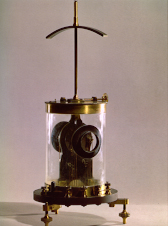
60.5 x 27.5
Steel, brass, copper and ebony
CAT. 1878 : 424
Dois galvanometros pequenos com campanula de vidro - um de fio fino, outro de fio grosso.
Two small galvanometers with glass bell jar - one made with thin wire and the other with thick wire.
Oersted's discoveries in 1819 and Ampère's work during the following year led to the appearance of a new kind of measuring instrument, the galvanometer. As he was conducting his experiments, Ampère soon realised that the behaviour of a magnetic needle under the influence of a current could be used to evaluate the intensity of the current in the conductor wire.
In 1820, Schweigger built a rectangular wooden frame on which he wound an insulated wire. This was called the Schweigger multiplier. A magnetic needle was suspended from a thin thread inside the coil. In the absence of electrical current the needle is oriented according to the magnetic meridian. When an electrical current is passed through the coil on the frame, the needle changes direction; the stronger the current, the more marked the deflection. To prevent the needle always being aligned with the magnetic meridian when there is no current, Nobili, in 1826, devised a static system. This comprised two cylindrical, parallel magnetic bars whose magnetic poles were symmetrically aligned. The system was built in such a way that one of the bars was inside the multiplier and the other outside. This configuration gave greater sensibility to Nobili's galvanometer, nullifying the torsion effect of the Earth's magnetic field. The apparatus with two needles mounted in this way was subjected to two pairs of symmetrical forces, avoiding torsion of the wire when there was no current passing through the multiplier.
In the same year as Nobili constructed his new galvanometer, Poggendorff built a system in which he installed a small flat mirror to reflect a relatively narrow beam of light. This apparatus, with the aid of an eyeglass, can be used to measure the torsion angle of the wire suspended from the bar or magnetic needle, when it is under the influence of the electrical current of the conductor.
Between 1833 and 1846, Gauss and Weber developed systems that were quite sensitive to the action of an electrical current, creating a model of an elliptical section multiplier, inside which a magnetic bar moved. These instruments were all built with fairly large magnets and had the disadvantage that they oscillated, with periods of high oscillation and with a slight damping, making measuring operations unduly lengthy.
In 1851, W. Thomson designed an extraordinarily sensitive system, far superior to the earlier ones in that the oscillation period of the moving components is shorter, and the damping more rapid. His galvanometer has two small magnetic needles placed inside two circular coils. The needles are suspended by a torsion thread and move in unison with a small flat mirror. The small size and reduced mass of the needles greatly lessens its period of oscillation. The system, therefore, quickly achieves the rest, in the new position of equilibrium. To reduce the effect of the Earth's magnetic field on the torsion of the thread holding the needles, Thomson used a slightly curved magnetic bar. The bar is mounted on a brass tube, through which the thread holding the needles passes, enabling it to be raised or lowered along the tube. The bar can rotate on its vertical axis, in line with the direction defined by the suspension thread. It is thus possible to orient it so that the magnetic field, around the needles, is virtually nil when there is no electrical current passing through the coils.
The model in the Gabinete de Física dates from 1858.Chwolson, O. D., Traité Élémentaire de Physique Théorique et Expérimentale, Paris, 1913, Tomo IV, pp. 1060-1095.